Christmas Quiz 2021
December 15, 2021 in Articles
Here are twelve questions for a short Christmas quiz. These questions relate to items from the 1950s, ’60s, ’70s and 1980s. With the 1980s now starting to be 40 plus years ago, many items have now become collectables – and we may remember when they were new!
Below are the twelve questions. As always, the answers are at the bottom of the page.
Last year’s questions can be found here: 2020 Christmas Questions.
Questions:
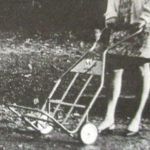
Q1: What advertised item could the Rainbow-Hasel Unikart carry?
A: 800′ of plastic-coated garden wire on a reel
B: 200′ of plastic hosepipe on a reel
C: 500′ of rubber-coated electric extension cable on a reel
—————-
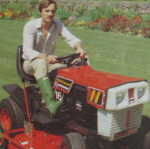
Q2: Westwood made many models, like the W16 shown, and also a diesel model.
A: Gazelle-Diesel
B: W12
C: D12-91
————————
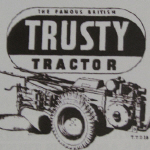
Q 3: What was the Whirlwind machine that Trusty produced?
A: A leaf blower
B: A broadcast spreader
C: A strimmer
—————-
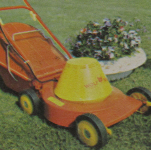
Q 4: Where did the Wolf company get their name from?
4. In 1964 Wolf Tools had new premises built at Ross-on-Wye, Hertfordshire. Wolf Tools were of German origin but where did they get the name Wolf from?
A: Wolf is the shortened name of the German town where the company was initially located
B: A wolf is the emblem of the German town where the company was founded
C: Wolf is the founding family surname
—————-
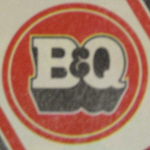
Q 5: Which mower was £99.99 at B&Q?
5. In 1986, B&Q DIY Supercentres advertised a range of lawnmowers. Prices ranged from around £40 for a basic electric machine to over £200 for a petrol-powered Suffolk Punch 43S. But which of the three listed electric lawnmowers, its modern sleek design and appealing colour no doubt adding to the price, was the most expensive at £99.99?
A. Qualcast Concorde E30 12” cylinder electric with 40’ cable
B. Flymo Chevron 350S electric rotary mower with 50’ cable
C. Black & Decker R12C electric rotary mower with 50’ cable
—————-
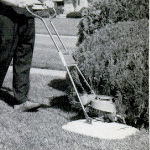
Q 6: Which company made the Flymo in the USA?
6. When Flymos’ patent for their hover mower design expired in the late 1970s, many manufacturers jumped on the hover mower bandwagon, marketing their own versions in many countries. However, in the 1960s, the Flymo was already available in the USA, it carried the Flymo brand name and also the manufacturer’s name. But which manufacturer made the Flymo in the USA?
A. Toro
B. Huffy
C. Jacobsen
—————-
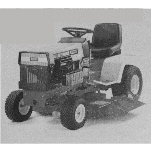
Q 7: What colour were the 1980s Gutbrods?
7. In 1988 Gutbrod GmbH, at the time one of Europes largest manufacturers of garden and cleaning equipment, became part of the Rotherberger (UK) Ltd group who were based in Northampton. They were devoting time and energy to developing a stronger presence in the UK for the Gutbrod range of garden machines which included electric and petrol mowers, lawn tractors, rotavators, lawn scarifies, leaf blowers etc. But what was Gutbrods chosen colour scheme that they used for all these machines in the late 1980s?
A. Blue and white
B. Red and white
C. Yellow and white
—————-
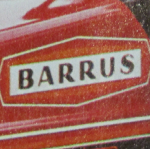
Q 8: What other garden item did Barrus sell?
8. E. P. Barrus Ltd based at Bicester is well known for retailing the extensive Lawnflite range of machinery. Around 1980 the range included a walk-behind leaf vacuum, a power-driven log splitter and a one-man petrol-powered post hole borer called the Boremaster. But what other different items did Barrus sell that they produced a
A. Gas barbecues
B. Croquet sets and lawn games
C. Garden statues
—————-
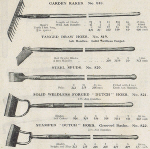
Q 9: Lots of tools for the gardener, but what was the Cultifork?
9. Spear & Jackson advertised a huge range of garden equipment, one of the more unusual tools was the Cultifork – folk may recognise the tool but not necessarily the name. This tool, priced at £3.73 in 1974, was originally designed by the writer and newspaper garden columnist Xenia Field. But what was the Cultifork?
A. A hand fork to aid in splitting smaller plants such as alpines, this avoided too much damage to the roots.
B. A garden fork with a unique configuration of prongs for cultivating and digging in compost and fertiliser in confined areas between border plants.
C. A combined fork and spade design that enabled heavy soil to be easily turned over and broken up.
—————-
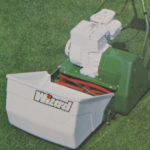
Q10: What other green and white Wizard machine was available?
10. In the 1970s, Wolseley Webb had a range of green painted cylinder lawnmowers, powered by electric, battery or petrol, they had white plastic grass boxes, these mowers were the Wizard models. Other than lawnmowers, what other green and white painted Wizard machine was available at the same time? Was it a…
A: Petrol-powered garden cultivator
B: Battery-powered hedge trimmer
C: Hand-powered lawn edger
—————-
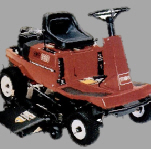
Q 11: What did the ‘HMR’ on the Toro ride-on mower mean?
A: Hydro-Multiple-Radius
B: Highly Manoeuvrable Rider
C: Hydro MoweR
—————-
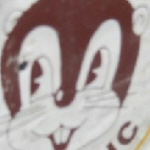
Q 12: Which manufacturer used this on their logo?
12. Many machines have been named after animals. Examples are the Hayter mowers called Kestral, Hawk and Osprey, the Bluebird scarifier by Bob Andrews and the Howard Bantam rotavator…and since it is December then there are the Robin engines. But which manufacturer used the name Beaver on their powered cultivators? Was it…
A: Landmaster
B: Merry Tiller
C: Norlett
—————-
Answers:
1: B: 200′ of plastic hosepipe. At the time Rainbow-Hasel made their hosepipe in 60′, 90′, 120′ and 200′ lengths of 1/2″ bore which would not kink – but we all know that even non-kink hosepipe kinks! Their hosepipe was made in a ‘Distinctive Green & High Glaze Finish’ and could be fitted into a wall-mounted reel to keep it neat, this reel could also be fitted to the Porto Reel and Unikart trollies to wheel the hose around the garden. The Rainbow name continues with the Rainbow buckle tree ties still able to be purchased today.
2: B.: W12. French trade reports mention that the Lombardini powered tractor with 12 hp had the model number W12. This follows other Westwood tractors with model numbers stating the engine horse-power such as W6, W8, W10, W11 and W16. However, it is unknown if any machines with W12 badges exist, regardless of trade reports they may all have eventually ended up coming out of the factory with D1200 stickers anyway! French reports state that the W12 was available with the choice of either a 91cm or 105cm wide mowing deck.
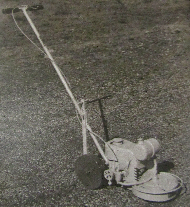
Answer 3: Trusty Whirlwind
3: C: A strimmer. The Whirlwind model (pictured) was available from 1957 and although marketed as a weeding tool it was more akin to a wheeled strimmer.
4: C: Wolf is the founding family surname. The name of the company in the UK was Wolf Tools for Garden and Lawn.
5: B. The Flymo Chevron 350S could be bought for £99.99 in 1986 at B&Q. The Qualcast Concorde E30 was £54.95, and the Black & Decker R12C which was a 12” rotary mower on a budget cost £39.99. Qualcast, Flymo and Black & Decker had large ranges of machines sold through DIY warehouses, they’d be easy for the customer to pick up on a weekend and take home and quickly be cutting the lawn….before it started raining on a Sunday afternoon.
6: A. In the USA in the 1960s the Flymo was made by the Toro Manufacturing Corp, Minneapolis. Generally, the mowers carried both the Toro and Flymo names. Toro held both the USA and Canadian licenses for the Flymo. Early magazine reports were that the USA made petrol machines had a 2.5 hp Tecumseh engine which powered a 19″ cutting blade at 3500 rpm.
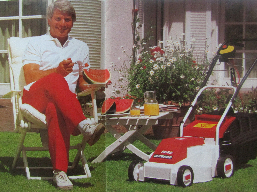
Answer 7: It had to be red for Gutbrod.
7: B. The Gutbrod machines in the late 1980s were painted red and white much like they always had been, although the colour scheme jumps out from the catalogues as all the gardeners and people demonstrating the machines in the catalogues are dressed in red and white, too! The machine range was robust and also innovative providing machines that would appeal to the professional user as well as the homeowner.
8: A. Around 1980, Barrus Ltd produced a special leaflet for gas barbecues. Many manufacturers have had associations with items other than machinery, for instance, Qualcast manufactured aluminium greenhouses. I’m unaware of any machinery manufacturer retailing garden statues, although the VHGMC proudly have a gnome.
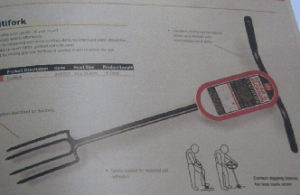
Answer 9: Spear & Jackson Cultifork
9: B. The Cultifork was advertised in the early 1970s as having a ‘scoop-shaped prong design which enabled cultivating between border plants, the fork worked by twisting it in the ground to break up the soil or work in the compost. It had an ordinary shaft made from ash and a polypropylene D-shaped handle. However, a later Spear and Jackson design as shown in the image, still using the Cultifork name, had an S-shaped steel handle to give easy leverage to the prongs when turning it. I have also seen this tool sold as the vintage Sqork (square fork) but haven’t found that name in contemporary marketing material.
10: A: A Wizard petrol-powered cultivator. According to the brochures, there is a 3hp version most suited to the home gardener and a 5 hp version which is better for the allotment. They were capable of digging 12″ deep and 26″ wide, attachments were available for ridging and inter-row work. Using the same paint colours as the lawnmower range, the cultivators can be found with green painted handlebars and chassis and a white painted Briggs and Stratton engine and a white belt guard.
11: B. Highly Manoeuvrable Rider was the ‘HMR’ on the Toro rider. The Rider had an interconnected steering system that enabled the front wheels to turn 80 degrees for a small 4-inch turning radius, additionally, dual 5-speed transmissions would drive each rear wheel independently. Toro made two models, a 12 hp model with a 38″ mowing deck, and a larger 16 hp model with a 44″ or 52″ deck. The HMR can be found in the UK although it’s unknown how many were sold – it may have only been a low number.
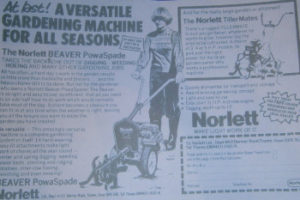
Answer 12: Norlett Beaver Powaspade Advert
12: C. Norlett used the Beaver name. This mostly appears on the petrol and the electric-powered Beaver Powaspade cultivators that had the out-front shaft and tines. Adverts detail that there were 14 attachments, these enabled digging, weeding, planting, ridging, inter-row work, trenching and mowing. The petrol version had a 2.5 hp Briggs and Stratton engine, the electric version had a 3000w motor. Reports state that the Powaspade, with advertising starting in 1975, was a great success for Norlett, this was probably because it was ideal for the domestic garden, was easy to use and had a range of attachments making it economical for a homeowner to buy.
Did you get all twelve correct?
